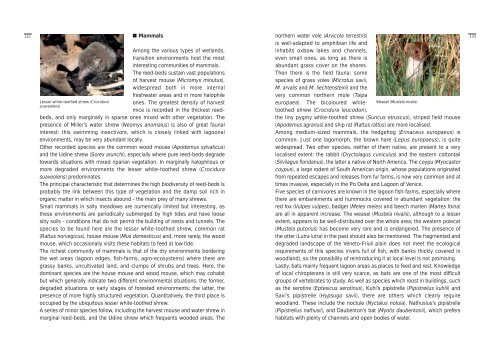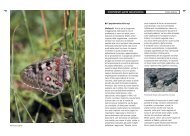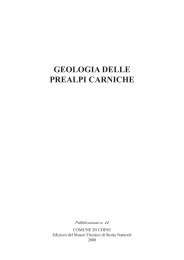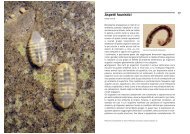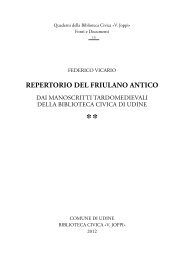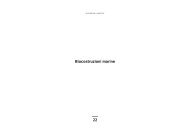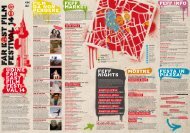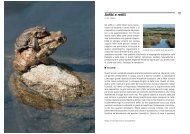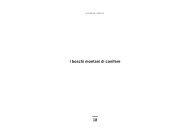Terrestrial invertebrates - Udine Cultura
Terrestrial invertebrates - Udine Cultura
Terrestrial invertebrates - Udine Cultura
You also want an ePaper? Increase the reach of your titles
YUMPU automatically turns print PDFs into web optimized ePapers that Google loves.
132<br />
Lesser white-toothed shrew (Crocidura<br />
suaveolens)<br />
■ Mammals<br />
Among the various types of wetlands,<br />
transition environments host the most<br />
interesting communities of mammals.<br />
The reed-beds sustain vast populations<br />
of harvest mouse (Micromys minutus),<br />
widespread both in more internal<br />
freshwater areas and in more halophile<br />
ones. The greatest density of harvest<br />
mice is recorded in the thickest reed-<br />
beds, and only marginally in sparse ones mixed with other vegetation. The<br />
presence of Miller’s water shrew (Neomys anomalus) is also of great faunal<br />
interest: this swimming insectivore, which is closely linked with lagoonal<br />
environments, may be very abundant locally.<br />
Other recorded species are the common wood mouse (Apodemus sylvaticus)<br />
and the <strong>Udine</strong> shrew (Sorex arunchi), especially where pure reed-beds degrade<br />
towards situations with mixed riparian vegetation. In marginally halophilous or<br />
more degraded environments the lesser white-toothed shrew (Crocidura<br />
suaveolens) predominates.<br />
The principal characteristic that determines the high biodiversity of reed-beds is<br />
probably the link between this type of vegetation and the damp soil rich in<br />
organic matter in which insects abound - the main prey of many shrews.<br />
Small mammals in salty meadows are numerically limited but interesting, as<br />
these environments are periodically submerged by high tides and have loose<br />
silty soils - conditions that do not permit the building of nests and tunnels. The<br />
species to be found here are the lesser white-toothed shrew, common rat<br />
(Rattus norvegicus), house mouse (Mus domesticus) and, more rarely, the wood<br />
mouse, which occasionally visits these habitats to feed at low tide.<br />
The richest community of mammals is that of the dry environments bordering<br />
the wet areas (lagoon edges, fish-farms, agro-ecosystems) where there are<br />
grassy banks, uncultivated land, and clumps of shrubs and trees. Here, the<br />
dominant species are the house mouse and wood mouse, which may cohabit<br />
but which generally indicate two different environmental situations: the former,<br />
degraded situations or early stages of forested environments; the latter, the<br />
presence of more highly structured vegetation. Quantitatively, the third place is<br />
occupied by the ubiquitous lesser white-toothed shrew.<br />
A series of minor species follow, including the harvest mouse and water shrew in<br />
marginal reed-beds, and the <strong>Udine</strong> shrew which frequents wooded areas. The<br />
northern water vole (Arvicola terrestris)<br />
is well-adapted to amphibian life and<br />
inhabits oxbow lakes and channels,<br />
even small ones, as long as there is<br />
abundant grass cover on the shores.<br />
Then there is the field fauna: some<br />
species of grass voles (Microtus savii,<br />
M. arvalis and M. liechtensteini) and the<br />
very common northern mole (Talpa<br />
europaea). The bicoloured white- Weasel (Mustela nivalis)<br />
toothed shrew (Crocidura leucodon),<br />
the tiny pygmy white-toothed shrew (Suncus etruscus), striped field mouse<br />
(Apodemus agrarius) and ship rat (Rattus rattus) are more localised.<br />
Among medium-sized mammals, the hedgehog (Erinaceus europaeus) is<br />
common. Just one lagomorph, the brown hare (Lepus europaeus), is quite<br />
widespread. Two other species, neither of them native, are present to a very<br />
localised extent: the rabbit (Oryctolagus cuniculus) and the eastern cottontail<br />
(Silvilagus floridanus), the latter a native of North America. The coypu (Myocastor<br />
coypus), a large rodent of South American origin, whose populations originated<br />
from repeated escapes and releases from fur farms, is now very common and at<br />
times invasive, especially in the Po Delta and Lagoon of Venice.<br />
Five species of carnivores are known in the lagoon fish-farms, especially where<br />
there are embankments and hummocks covered in abundant vegetation: the<br />
red fox (Vulpes vulpes), badger (Meles meles) and beech marten (Martes foina)<br />
are all in apparent increase. The weasel (Mustela nivalis), although to a lesser<br />
extent, appears to be well-distributed over the whole area; the western polecat<br />
(Mustela putorius) has become very rare and is endangered. The presence of<br />
the otter (Lutra lutra) in the past should also be mentioned. The fragmented and<br />
degraded landscape of the Veneto-Friuli plain does not meet the ecological<br />
requirements of this species (rivers full of fish, with banks thickly covered in<br />
woodland), so the possibility of reintroducing it at local level is not promising.<br />
Lastly, bats mainly frequent lagoon areas as places to feed and rest. Knowledge<br />
of local chiropterans is still very scarce, as bats are one of the most difficult<br />
groups of vertebrates to study. As well as species which roost in buildings, such<br />
as the serotine (Eptesicus serotinus), Kuhl’s pipistrelle (Pipistrellus kuhlii) and<br />
Savi’s pipistrelle (Hypsugo savii), there are others which clearly require<br />
woodland. These include the noctule (Nyctalus notula), Nathusius’s pipistrelle<br />
(Pipistrellus nathusii), and Daubenton’s bat (Myotis daubentonii), which prefers<br />
habitats with plenty of channels and open bodies of water.<br />
133


